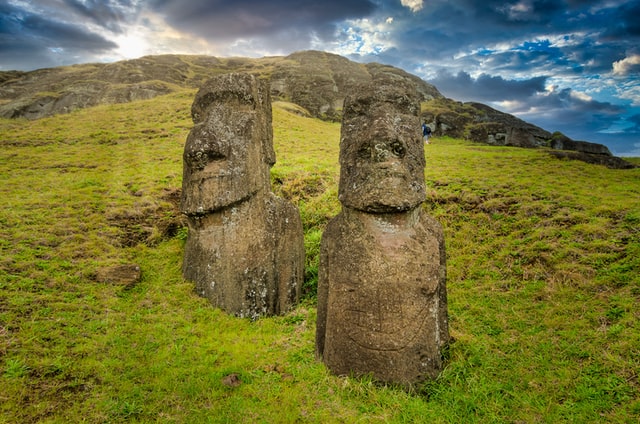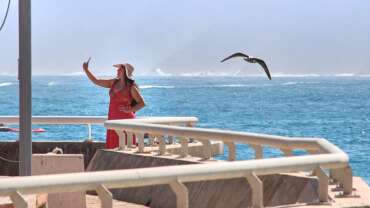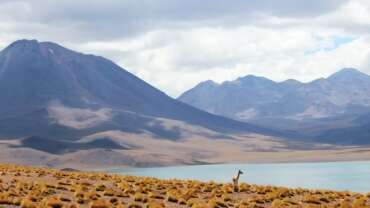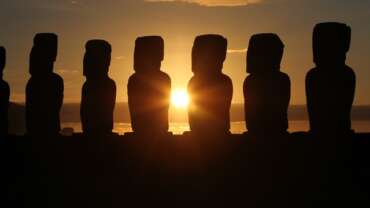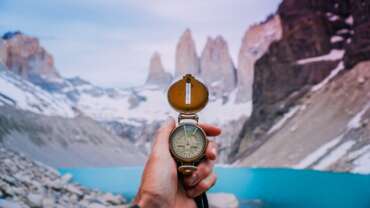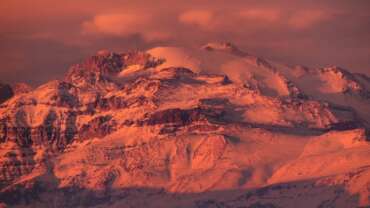Cultural Tourism in Chile
Chile’s cultural roots are as diverse as its landscapes, and have shaped the uniquely Chilean identity. Spend time with the indigenous peoples and experience their traditions! Discover unique archaeological relics and explore the country’s history in its many museums.
Immerse yourself in the ways of the northern Altiplano (highland) villages to learn more about the Aymara people and their traditions.
Discover the spirited Mapuche people of the central and southern heartlands, where you can sleep in a ruca, sample their traditional dishes and learn about the curative properties of the medicinal plants widely grown to this day.
On Rapa Nui (Easter Island), visit the enigmatic moai and coddle yourself with the island lifestyle.
Listen to the legends of the storytellers on Chiloé and visit the island’s famous churches, 16 of which have been declared UNESCO World Heritage Sites.
And don’t miss the traditional festivals throughout the country! You will be warmly welcomed at the grape harvest fiestas in the central wine-growing regions, the festival of La Tirana in the Atacama desert and the splendid Con la Fuerza del Sol carnival in the north.
INDIGENOUS PEOPLES AND ETHNO-TOURISM
Enrich your awareness of Chile’s fascinating indigenous cultures. Sample their delicious food, witness their traditions and perhaps experience for yourself a mystical connection with these people who keep their ancient traditions alive even in modern times.
The Mapuche people, renowned for their warrior spirit, still speak their curious ancient language, Mapudungun. For a truly unforgettable experience, visit a traditional ruca, or communal dwelling place, at Budi Lake close to Temuco, where you’ll sleep, cook and eat traditional food alongside Mapuches. Unmissable!
In northern Chile, you’ll meet the Aymara people of the Altiplano (or highlands) in the villages of Putre and Parinacota. See their beautiful textiles and colorful handicrafts made from llama wool, and sample llama and alpaca meat with a side-dish of quinoa.
Rapa Nui (Easter Island) is simply fascinating, with its fascinating legends, ancient traditions kept alive in festivals such as Tapati, and distinctive music, dance and language.
Finally, at the very end of the earth, observe the age-old ways of the Yagan, an indigenous people who still sail in their traditional canoes through the channels and inlets of Tierra del Fuego.
WORLD HERITAGE SITES
Chile’s vast territory includes many unique places of exceptional natural importance, as well as cultural sites of great significance to humanity.
Their importance is such that in order to promote and preserve them for future generations, UNESCO has accorded them World Heritage Site status.
Discover these unique places where history is woven into singular landscapes. Trace the steps of the past as you walk towards the future of Chile.
Explore World Heritage Sites of Chile
QHAPAQ ÑAN
A road surrounded by traditions and mysticism that takes you back in time and invites you to discover the stories of the empire that conquered the sun, that’s the Qhapaq Ñan.
This amazing road network built over many centuries by the Incas, joined immensely contrasting areas; from the snow-capped Andes to the coasts of the Pacific, passing through tropical rainforests, fertile valleys and completely arid deserts.
A pre-Inca legacy whose universal message is the heritage and culture of the indigenous peoples and communities of Argentina, Bolivia, Chile, Colombia, Ecuador and Peru, who share their past on the stones of the Inca Trail.
Follow in the footsteps of the Incas and discover the mysteries hidden after the construction of this archaeological journey.
THE “CHINESE DANCES”
Ancient songs mix with the sound of flutes and drums, reliving 350 years of traditions and devotion. The popular fervor gathers families and neighbors, men who are at the center of a sacred devotion for religious divinities, expressing their faith through music, dancing and special garments.
Enjoy these one-of-a-kind dances in one of the several religious festivals that take place in the center and north of the country, like the Festival of La Candelaria, Nuestra Señora del Rosario de Andacollo and La Tirana.
Visit ceremonial places and be witness to this religious-musical tradition that exhibits part of the country’s cultural diversity. Discover the traditions of Spanish heritage and be amazed by the traits of the indigenous peoples.
RAPA NUI NATIONAL PARK
On the world’s most remote inhabited island, millennial enigmas and legends are hidden. Right in the middle of this Polynesian natural beauty, like a written code that nobody has cracked, you’ll find the legacy of the Rapa Nui culture.
Get to know how a society completely isolated from the world for centuries was able to create a culture that is unique in Polynesia and indeed the world. Visit the Rapa Nui National Park, living witness of artistic traditions and a place that is home to a large number of universally relevant archaeological sites.
Discover the famous and enigmatic moai, maximum expression of the Rapa Nui and discover the origin of a millenial culture that’s still alive. If you want to know more about Rapa Nui traditions, visit the island for the Tapati festival that takes place every year from late January to early February.
CHURCHES OF CHILOÉ
In Chiloé, the curanto, the mingas and the legends have given the island its magical flair. But it is its churches which have given the area its architectural charm as they create an eternal dialog with the landscape.
Visit these churches at the end of the world and discover some of the oldest wooden constructions still standing on the planet. Built during the 17th century to serve in the evangelization of the new world, they mix Spanish design with the typical techniques and materials of the island. Also, the assembly technique and joints built with native wood create an architecture that’s unique in America.
The 16 churches, declared World Heritage Sites by UNESCO, form the “Churches of Chiloé”. Nine of them are on the eastern coast of the Big Island, three in Lemuy, two in Quinchao, one in Caguach and one in Chelin.
There are less than 10 kilometers between these churches. See all of them in just one day and learn more about the pecularities and myths that surround them!
HISTORIC QUARTER OF VALPARAISO
Experience the power of the Pacific among a labyrinth of houses with ocean views crammed into the hillside. Discover the architecture and culture surrounding the city’s historic district, testimony of a story that began in 1536.
Visit Chile’s most important port set into hills that you can visit using long staircases and funiculars (elevators on rail tracks). Museums, open spaces and public monuments, along with institutional buildings, give the city an authentic port-city feel and make it one of the few places in the world where Victorian architecture was successfully adapted to the rough and treacherous geography of the area.
Valparaiso was witness to early globalization and the clash of cultures during the 19th century, and today arises as one of the cities with the most stories, magic and life of the entire country. Come and discover it!
HUMBERSTONE AND SANTA LAURA SALTPETER OFFICES
The history of white gold envelops and joins two saltpeter offices that became the world’s most important saltpeter mine at the turn at the 20th century. The union of different communities, knowledge and skills turned this industry into a complex space of cultural exchange.
The transformation of the saltpeter mines and industrial settlements into a community with their own language, organization, traditions and creative expressions will still charm those today who visit these ghost towns in the middle of the Atacama Desert.
Visit the settlement of Humberstone and the industrial area of Santa Laura and relive the glory days of saltpeter and the memories of one of the most glamorous periods of Chile’s history.
MINING TOWN OF SEWELL
Known as the city of stairs, the Sewell mining camp breathed life into one of the country’s most important companies. Discover the beginnings of the El Teniente Division, the world’s largest underground copper mine.
Get to know the legacy of the Company Town, a true record of a worldwide phenomena that marked an important period of Chilean history. Unearth the remains of the settlement’s glorious past that contributed to the global spread of large scale mining technology.
Visit the facilities of a city marked by austerity, functionality and modernity in the middle of the Andean landscape. Stage of mining tragedies and industrial processes, Sewell invites you to listen to the whispers of history engraved on the walls of the mining settlement.
ARCHAEOLOGY
Known as the “naval of the world”, located in the middle of the huge Pacific Ocean, the enigmatic Moai welcomes you by the sea in the magical Rapa Nui (Easter Island) and can not wait to show you the interesting island culture.
Relive the origins of Chile’s indigenous peoples and enjoy the wonderful petroglyphs engraved on rocks and the giant geoglyphs on the hillsides of Chile’s north. Take a bike ride around San Pedro de Atacama and discover the Pucará de Quitor. The Chug Chug geoglyphs one of the most important geoglyphs in Chile.
And if we talk about ancient wisdom, prepare to be amazed at the Chinchorro culture in Arica. Their mummies, product of an artificial mummification process, date back to 5,000 BC. Don’t miss the opportunity to see them; they are the oldest mummies in the world!
In the capital, Santiago, open your eyes and cultivate your wisdom at the Visual Arts and Archaeology Museums located at the heart of the Lastarria District. With an interesting collection of Diaguita, San Pedro and Molle pottery, as well as Mapuche jewelry, they welcome you every day.
If you’re hungry for more, the south of Chile has a well-kept secret in store for you. The Monte Verde archaeological site, close to Puerto Montt, is the oldest human settlement on the continent, dating back more than 33,000 years. You must see it!
MUSEUMS
Discover the history, art and interesting collections of the museums in Chile. Get to know the life of great characters, artists, memorable events, the evolution of species, of science and much more. Walk through large manors or modern buildings with displays full of invaluable memories and artifacts.
Soak up the Chinchorro culture and the world’s oldest mummies at the San Miguel de Azapa Archaeological and Anthropological Museum. Visit the National History Museum and learn more about colonial times and about the country’s independence process. And at more modern buildings, enjoy visiting the Pre-Columbian Museum and the Museum of Memory and Human Rights.
What about some Chilean art? Be transported to the main art galleries of the world while taking a tour through the hallways of the National Museum of Fine Arts in the Lastarria district in Santiago, an amazing 1910 building that holds works by Chilean artists such as Roberto Matta and Claudio Bravo among others.
Breathe in the fresh air among the vineyards of the Colchagua Valley and discover the Colchagua Museum, which has an amazing museography and a collection of carriages, jewelry, clothing and trains that will surprise you. And a bit further south, while visiting the Arauco Territory, relive Mapuche culture and soak up its traditions at the Cañete Mapuche Museum.
PALEONTOLOGY
For the lovers of this science and those that are curious about nature, the Paleontology Museum will be your first stop in Chile. Discover and learn more about our ancestors and get to know the species that roamed the earth before us. You’ll be surrounded by mammoth teeth, remains of plesiosaurus and glyptodons, of sharks, dinosaur eggs, the embryo of a T-rex and plant fossils during this interesting trip.
At the Natural History Museum, located at the heart of the beautiful Quinta Normal Park, you’ll be surprised by a room full of vertebrate fossils from the Mesozoic period, you’ll also find the amazing Carnotaurus Sastrei dinosaur, as well as several exhibitions which will make for a super fun experience.
Do you know anything about the Milodon? This was a prehistoric herbivore (Mylodon darwini) related to the sloth which had big claws and was colossal in size. It sadly went extinct thousands of years ago. Its cave is located in the south of Chile, in Puerto Natales. Walk through the caves and capture the moment, posing next to its replica at the entrance of this natural monument.
And since we’re talking about fossils, in the north of the country you’ll find the “Bahía Inglesa Formation”, a fossil site with rich diversity which holds more than 70 species and visit the Caldera Paleontogical Museum to be surprised by a 10 million-year-old whale skull.
POETRY AND LITERATURE
Chile is called the country of poets. Witness this while following in the footsteps of its Literature Nobel Prize winners and enjoy the rich oral tradition, popular narrative and sharp pen of street artists that receive spontaneous applause.
At the Elqui Valley, let yourself be charmed by the verses of Poet laureate Gabriela Mistral. Visit her family´s home, which was made into a museum named after her in the town of Vicuña, where you will find some of her works and personal belongings.
In the central area, discover the so-called coast of the poets to feel the great influence of Pablo Neruda. Let yourself be taken in by his beautiful craziness and visit his Museum Homes of Isla Negra and La Sebastiana in Valparaiso. In Santiago, a must-see is his home, La Chascona in the Bellavista District. In Temuco, you’ll get to know the more intimate part of his history, which evokes his childhood at his family´s home and of the influence he received in the neighborhood where he grew up.
On the magical islands of the Chiloé archipelago you can relive some of the best-sellers of writer Isabel Allende and discover why her characters travel to the Big Island to get over their miseries. If we talk about artists, the song-writer and poet, Violeta Parra is another character you can’t miss. Take part in the guided tours of her museum and cultural center in Santiago to learn more about her love for national folklore.



